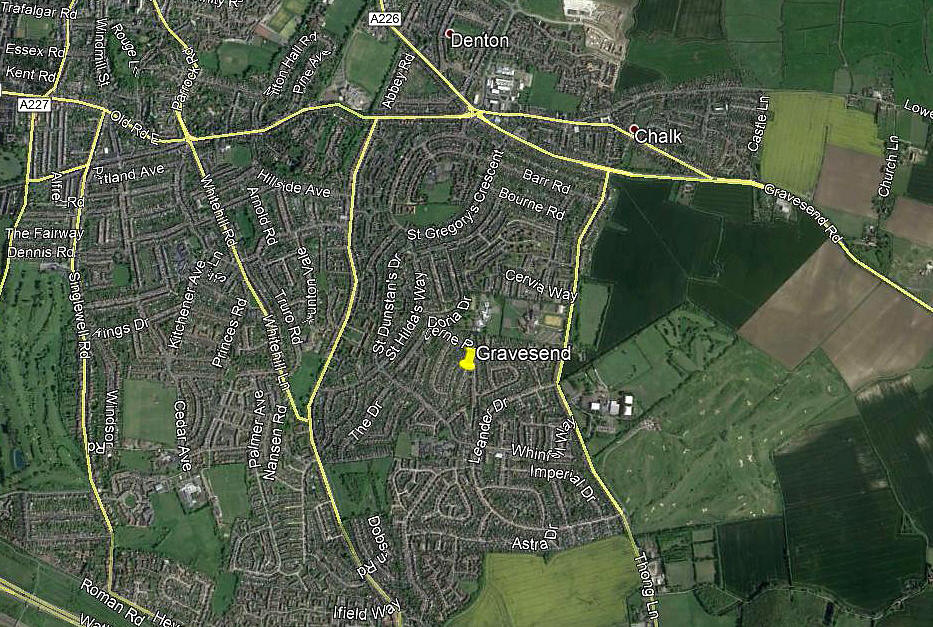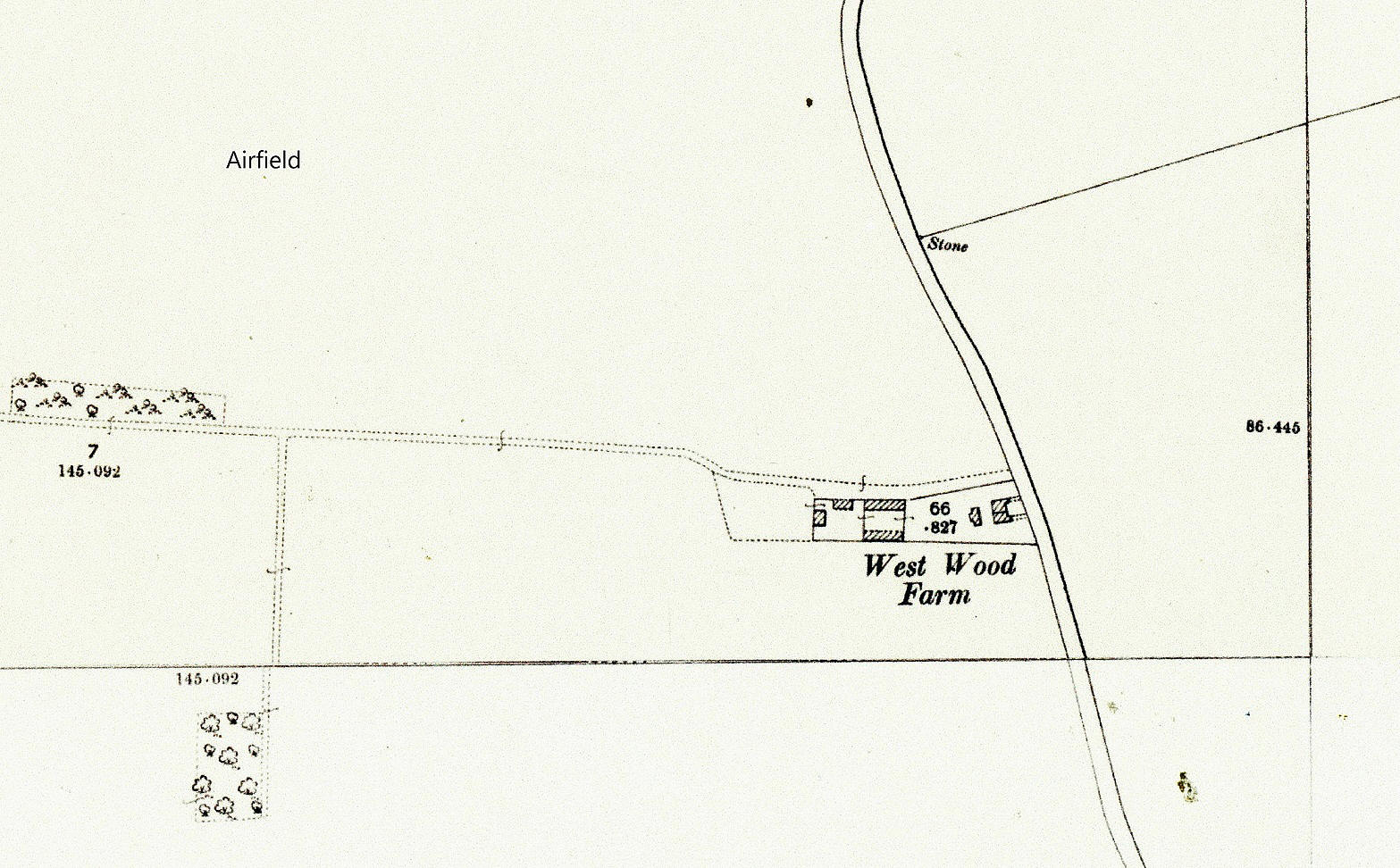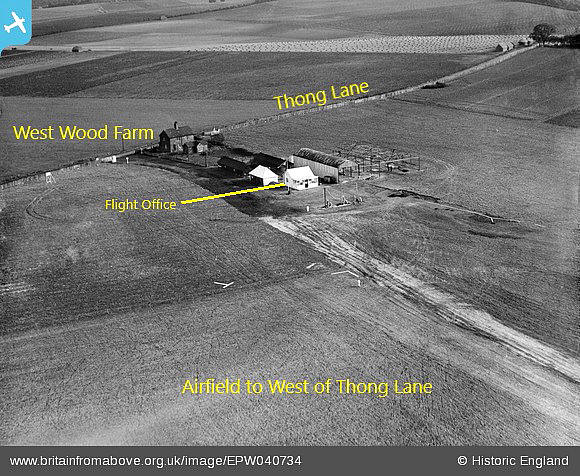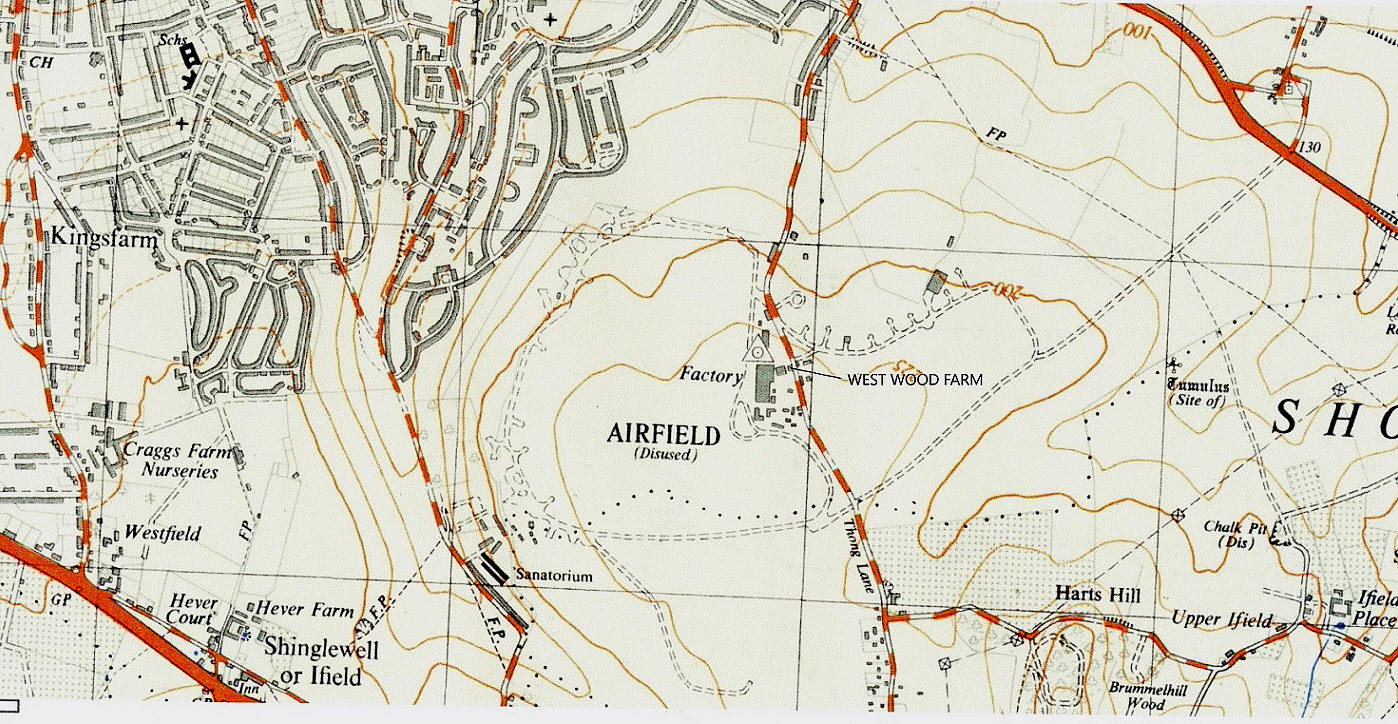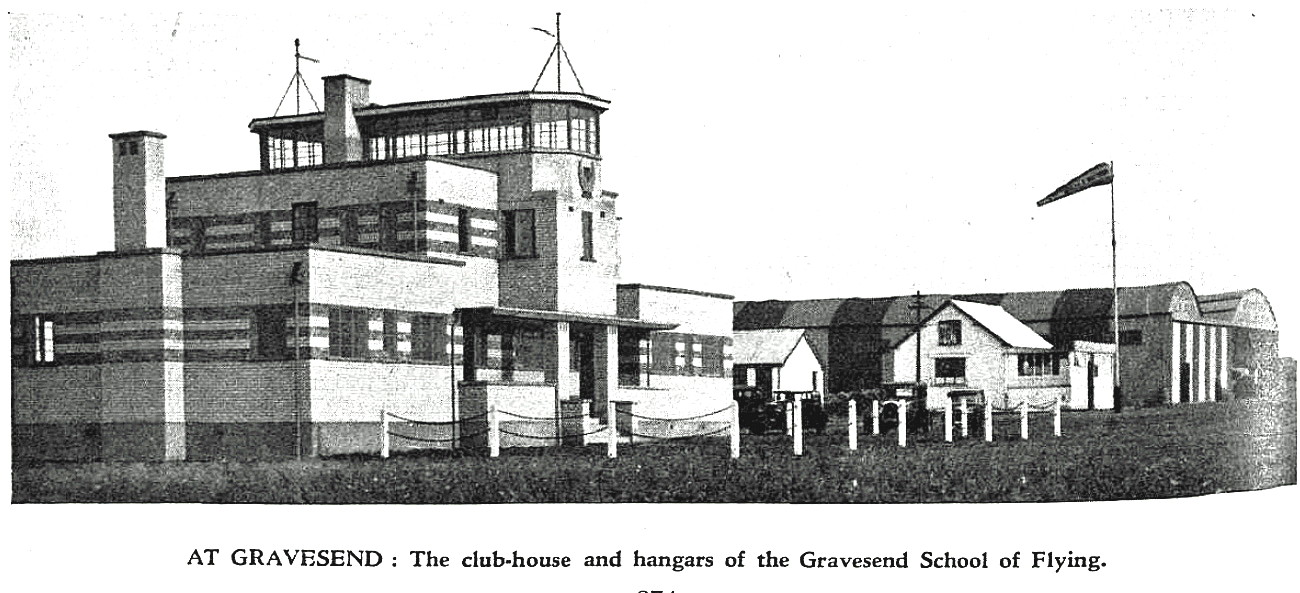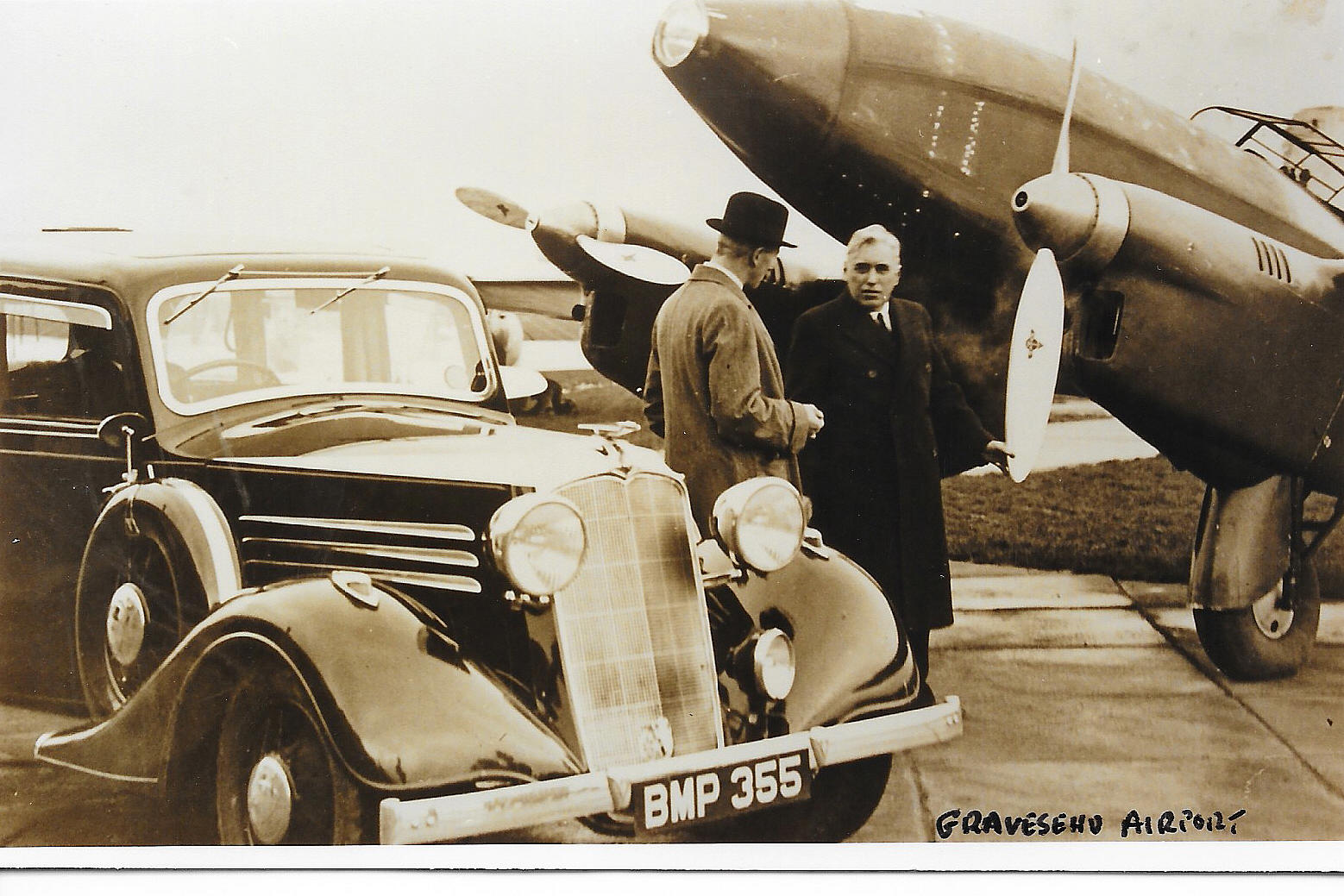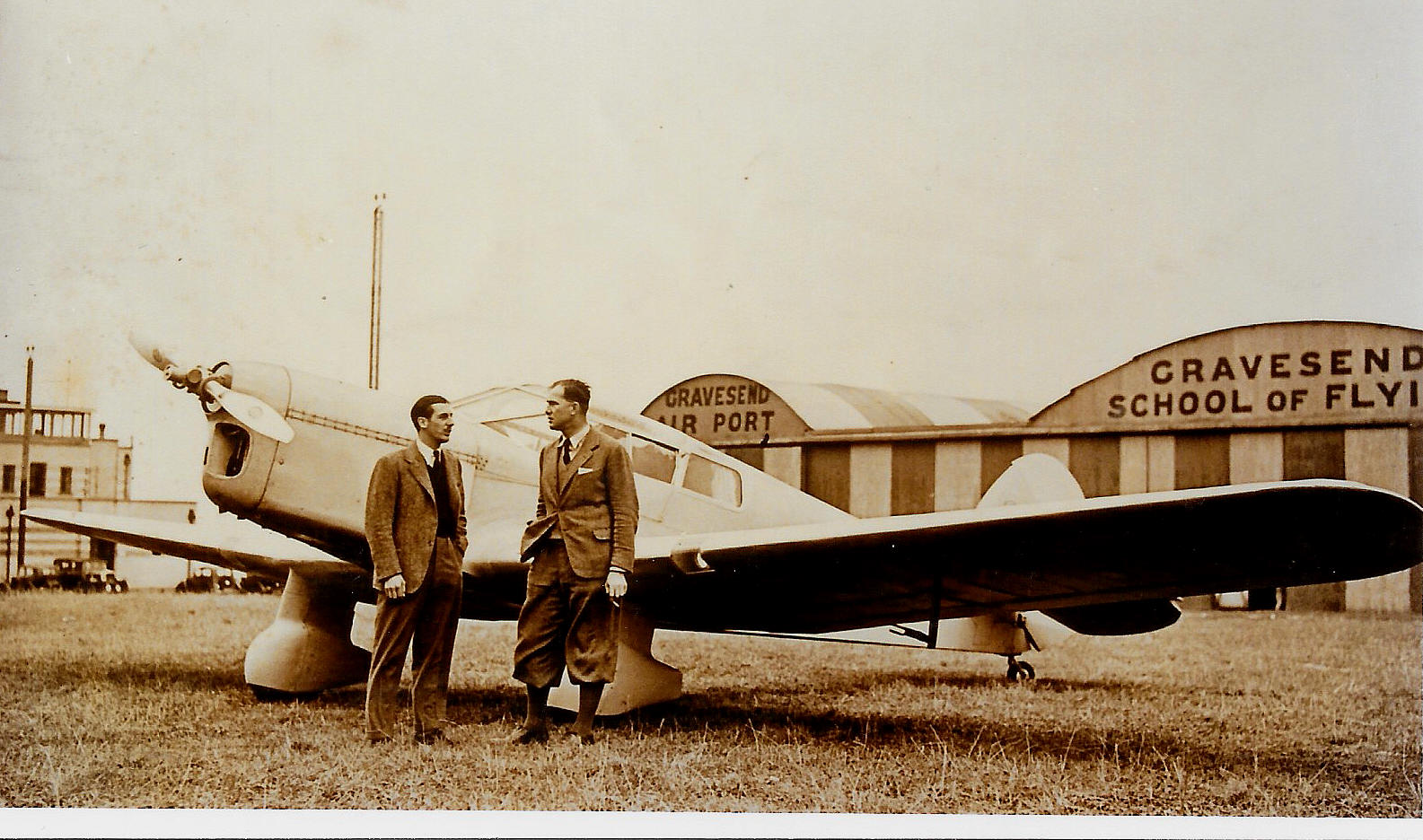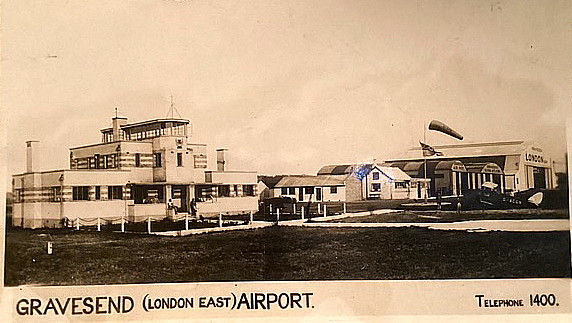Gravesend
GRAVESEND see also MILTON HALL
GRAVESEND: Civil ‘airport’ later military aerodrome * (Aka GRAVESEND AIRPORT)
(Also known as THE AERODROME and at some point GRAVESEND - LONDON AIRPORT EAST). It failed to attract scheduled services but was used as a diversion airfield by several airlines operating into CROYDON (LONDON). In 1933 to 1934 aka GRAVESEND AERODROME.
Note: This recent picture was obtained from Google Earth ©
Unlike so many other WW2 airfields, where traces of the layout can still be seen, GRAVESEND has been totally obliterated by housing.
Note: These two maps and the picture were kindly sent by Mr Michael T Holder. The first map and picture appear to show GRAVESEND as it was being developed in 1932.
Note: In 2022 Mike Holder, who has become a great friend of this 'Guide', found this picture published in Flight magazine on the 31st August 1933. It certainly shows just how quickly GRAVESEND was being developed in the early 1930s.
Operated by: In 1933 it appears: Gravesend Aviation Ltd
Both these most evocative pictures from postcards were kindly sent by Mike Charlton who has an amazing collection. See www.aviationpostcard.co.uk
First picture: I can find no record of one of the de Havilland DH88 Comets visiting GRAVESEND. They were deliberately built and first flew in 1934 to compete in the MacRobertson Air Race from England to Melbourne in Australia. The race departing from MILDENHALL in October 1934 and being won by the DH88 G-ACSS 'Grosvenor House'.
Can anbody kindly offer advice regarding this picture. It would appear from the paint damage caused by the propellers on the fuselage that this aircraft had already flown a substantial distance. So could this be a visit by G-ACSS after competing in the race?
Second picture: This 'classic' aircraft clearly has all the Percival traits stamped upon it. Sadly I lack the confidence and knowledge to pin it down to a particular type. Can anybody kindly offer advice? And also I wonder, could one of the gentlemen pictured be Percival?
Military users: From 1937: 20 ERFTS (Tiger Moths)
*Battle of Britain RAF Station 11 Group
(10th July 1940) 610 Sqdn (Vickers-Supermarine Spitfires)
(1st August 1940) 501 Sqdn (Hawker Hurricanes) Still here 1st September 1940
66 Sqdn (Spitfires)
WW2: RAF Fighter Command 11 Group
(Initially at least a satellite for BIGGIN HILL)
At the very least Blenheims, Defiants, Hurricanes, Mosquitos, Mustangs, Spitfires and Tempests would have been seen here during WW2
4, 19, 65 & 122 Sqdns (North American P.51 Mustang Mk.1s)
21, 464 (Australian) and 487 (New Zealand) Sqdns (DH Mosquito FB VI’s)
32, 50 & 85 Sqdns (Hawker Hurricanes)
19, 64, 66 (French), 72, 74, 92, 122, 124, 133 (Eagle), 306 (Polish), 401 (RCAF), 609 & 689 Sqdns (Vickers-Supermarine Spitfires)
141 & 264 Sqdns (Boulton Paul Defiants, probably mainly for night fighter duties)
174, 193, 245, 247, 264 and 266 Sqdns (Hawker Tempests)
604 Sqdn (Bristol Blenheims)
277 (ASR) Sqdn (Boulton Paul Defiants, Supermarine Sea Otters, Spitfires & Walrus and Westland Lysanders).
Note: Operated from December 1942 to April 1944. Moved here from STAPLEFORD TAWNEY (ESSEX) then moved to SHOREHAM (SUSSEX).
Air taxi: 1932 to 1939: Gravesend Aviation (With just one DH.60 Moth it seems - G-AAKX)
Flying school: 1932 to 1939: Gravesend Aviation (With just one DH.60 Moth it seems - G-AAKX)
Aka Gravesend School of Flying? Gravesend School of Flying and Aerodrome Club*
Manufacturing: CLW Aviation. They built just one aircraft, (in Bexleyheath), the CLW Curlew G-ADYU which was then assembled and first flown here on the 3rd September 1936
Essex Aviation is an interesting case. First set up at STAPLEFORD TAWNEY (ESSEX) in 1935. The founder of the company being Jack Cross who had been the Chief Engineer for Hillman Airways. This company became famous for the preparation of racing and record-breaking aircraft, especially Alex Henshaw’s Mew Gull G-AEXF for the Cape Town return flight and A E Clouston’s DH.88 Comet.
It appears Percival set up a factory here in 1934, (some say 1933), before moving to LUTON in December 1936. Prior to that it is said Percival sub-contracted to B.A.C. at Maidstone and then Parnell at YATE. It appears B.A.C. only built the first Percival Gull G-ABUR.**
Pleasure flights: Pre 1939: British and Continental Airways, Thanet Aviation
Location: About 2nm SE of Gravesend town centre
Period of operation: 1932 to 1956 (some say 1958?)
Runways: ‘All over’ grass airfield in the 1930s? Max landing run in 1933: 1079 grass
WW2: NW/SE 1298 grass ENE/WSW 1353 grass
NOTES:
FLYING CIRCUS VENUES
The 165th venue (12th October 1932) for Alan Cobham’s quite amazing National Aviation Day UK Display Tour.
2nd venue for Alan Cobham’s 1933 No.2 Tour of the UK on 16th April.
74th venue (1st July 1934) for Cobham’s 1934 Tour of the UK.
Final and 72nd venue for the first ‘complete fleet’ part (30th June) of Cobham’s 1935 Tour which then split into two sections - The No.1 Tour and No.2 Tour.
SOMETHING TO BE EXPLAINED?
According to Ron Smith in his excellent series British Built Aircraft, in this case Vol.3; Shorts first flew their Scion G-ACJI here on the 19th August 1933. Can an explanation of why this aircraft flew from here rather than ROCHESTER be provided?
THE GRAVESEND SCHOOL OF FLYING
*The Gravesend School of Flying and Aerodrome Club was listed in Flying – The Light Aeroplane Weekly in their compilation of UK Flying Clubs & Landing Grounds 1933-34. Without much doubt the Gravesend School of Flying, found in various accounts, is one and the same, but presumably Gravesend Aviation was another operation entirely.
A rare 1927 Blackburn Bluebird (G-EBRF) was based here in 1936, and destroyed during a fire-fighting display in 1937.
THE PERCIVAL HISTORY
As pointed out elsewhere, there is a very good reason for calling this project a ‘Guide’. And, I would argue, a ‘Guide’ like this really should try to illustrate possible if nor not probable examples of misinformation, let alone the multitude of items for debate or conjecture? For example;
You really would think, surely, that the history of the Percival Company would be engraved in stone by now? Beyond any question? But no, I have found ‘records’ of Percival setting up in LUTON about two years before the original factory opened here, which it seems took place in late 1933 and early 1934? Edgar Wikner Percival was an Australian, born in Albury in 1898, and it seems he sub-contracted his earliest designs to both BAC in Maidstone and Parnell at YATE before taking the decision to become an independent manufacturer at GRAVESEND.
What intrigues me is the frenetic rate with which the three main light aircraft companies of the 1930s, (de Havilland, Percival and Philips & Powis with Miles designs) produced new models. Here, in the space of just two years, they produced twenty-two Percival Gull types, six Mew Gulls, the prototype Vega Gull and the Gull Six. They also built a special Gull Six with two tandem open cockpits for the Maharajah of Jodpur. Today it might take that long, or more, to get a major modification authorised! Even a decade or more seems usually required to fully develop even a light aircraft, sometimes much longer.
Incredible isn’t it? Just three companies dominated the zenith of British light aircraft manufacturing in the 1930s: de Havilland, (STAG LANE & HATFIELD), Philips & Powis with Miles designs (READING/WOODLEY), and Percival, (GRAVESEND & LUTON).
AN AMAZING FLIGHT
It is reported that in June 1935 Edgar Percival flew a Gull to Oran in Morocco, and back in a day!. A round trip of 2300 miles. This would still be a phenomenal feat even today in an aircraft of a similar type, some eighty years later. Just one small point – Oran is also a place in Algeria and a staging point for Alex Henshaw during his astonishing ‘Cape’ flight (see below). Which can of course add confusion.
GRAVESEND AS AN 'AIRPORT'
Although called an “airport” it appears that no scheduled operations ever took place despite it getting Customs status from December 1933. However, it was used as a diversion airfield for CROYDON by several airlines including the German airline DLH, Imperial Airways, KLM, Sabena and Swissair. At one time it was hoped that KLM might adopt GRAVESEND as it’s London terminal and later it was also hoped that Air Despatch would call in on the planned ‘Inner Circle Line’ service around London but all these plans were dropped.
THE PERCIVAL 'GULLS'
The first Percival P6 Mew Gull G-ACND first flew here in March 1934 and the prototype Vega Gull made its first flight here in November 1935. It appears that production of the Gull Six actually took place at LUTON after Percival moved there in October 1936. The New Zealander Jean Batten used the Gull Six G-ADPR (developed here) for many of her long distance flights. Without wishing in any way to diminish the achievements of Amy Johnson, or Amelia Earhart etc, Jean Batten was in an altogether superior class. Unfortunately for her legacy it might seem, she didn’t kill herself, so isn’t much remembered today. How cruel history can be!
In 1936 another rare type first flew here on the 23rd May. This was the Perman Parasol G-ADZX flown by Mr A E Clouston. Later referred to as the Clouston Midget and, in October 1936, called the Perman Grasshopper.
AMY JOHNSON
She made her first attempt for setting a 'Cape' record in the Percival Gull Six (G-ADZO) in April 1936, but ground-looped at Colomb Becharn the edge of the Sahara, seriously damaging the aeroplane. As pointed out elsewhere, Amy Johnson was not a gifted 'natural' pilot and always struggled to get to grips with very basic piloting techniques. However, far from being daunted, she departed from here once again on the 4th of May, (in G-ADZO).
To quote from the excellent biography by David Luff, Amy Johnson - Enigma in the Sky; "This time, she not only beat Tommy Rose's time for the outward flight by eleven hours but, with only a three day break as against his three weeks, she set a new record for the return journey."
"It was a remarkable achievment by any standard, since not only did she fly home by what was for her an unknown route, via Johannesberg, Khartoum, Cairo and Athens, but overall she knocked one and a quarter days off her rival's time for the 14,400 mile flight." Once again, probably on the point of exhaustion, she totally mishandled her landing at Cairo, but stopped virtually against the airfield boundary.
ALEX HENSHAW
When in 1937/38 Alex Henshaw acquired the Percival P6 Mew Gull G-AEXF, and based it at GRAVESEND, the Percival company had already moved to LUTON (BEDFORDSHIRE). But what Alex must have been interested in was the help of Jack Cross who ran Essex Aero at GRAVESEND and this Mew Gull was fine tuned and cleaned up aerodynamically. The result was that Alex went on to win the 1938 King’s Cup air race with 20 laps of a 50 mile course averaging 236.25mph, a record for the pre-war WW2 years.
Today few people know about the existence of GRAVESEND AIRPORT or that one of the most incredible British record breaking flights started and ended here. By sheer bad fortune this was the year Great Britain entered into what was to become WW2 so the story almost vanished without trace for several decades. It was Alex Henshaw who, (in the Mew Gull G-AEXF which Jack Cross had modified to have a nine hour endurance), departed here on the 5th February 1939 for Cape Town. Alex and his father had previously surveyed the route and his first stop was Oran in Algeria. A 1300 mile leg across the Sahara followed with just two more stops in the Belgian Congo and Angola arriving at Wingfield aerodrome in Cape Town having taken just 39 hours 23 minutes to cover the 6377 miles at an average speed of 209.44mph.
The very next day Alex took off to fly back to GRAVESEND arriving at 1.51PM on February 9th. He was so ill and exhausted he needed assistance to get out of the aeroplane but had broken the record to the Cape by an astonishing 30 hours and 45 minutes, a record that stood firm until seventy years later when broken by Steve Noujaim flying a Vans RV7.
What really needs to be understood is that the aeroplane he selected to do this in, a Mew Gull racer, is very small and had little room in the tiny cockpit for unfolding charts etc. He flew by day and at night, often through appalling weather, and it is a wonder he survived at all. Think about it, 12,744 miles in four days, on one sector spending 10 hours and 15 minutes cramped into a space few of us would want to spend even an hour or more flying in.
WORLD WAR TWO
It is a sad fact that due to the way history is portrayed, (in the popular sense at least), it invariably becomes grossly distorted. How many today remember that GRAVESEND was also a significant ‘Battle of Britain’ airfield? I certainly didn’t until embarking on research for this ‘Guide’. When the Luftwaffe mounted their first ‘thousand’ aircraft raid targeting London on the 7th September 1940, (nothing like this had ever been seen before), the RAF were caught out and those unfortunate enough to be stationed at GRAVESEND were the first in the main firing line. Up to this point the raids had been on RAF airfields and 23 squadrons were up to defend airfields and industrial sites. This example of Luftwaffe planning was a true masterpiece of aerial warfare strategy. So presumably our great ally in WW2, the chief of the Luftwaffe, Hermann Göering wasn’t involved?
Various echelons flew zig-zag headings to confuse the RAF before merging on London. When the RAF ‘top brass’ in 11 Group finally realised that London was the target they had only four squadrons initially ready to ‘scramble’ to attack this immense force. Think about it. There were 348 bombers in the fleet, stacked up from 14,000 to 20,000ft. Above this a truly staggering number of 617 fighters were stationed to destroy every Hurricane and Spitfire in sight. The four squadrons sent up to intercept this ‘aerial armada’ were No.1 and 303 (Polish) squadrons from NORTHOLT, 504 squadron from HENDON and 501 squadron from GRAVESEND.
12 Group had been sent an urgent message to help, ASAP, but typically they failed to be of any help worth mentioning. Leigh-Mallory was much more interested in his personal agenda to fight Dowding and Park and get the ‘Big Wing’ idea accepted than defend England. A matter for some debate perhaps these days, but the facts do I think speak for themselves?
A DANGEROUS BUSINESS
Teaching people to fly has always traditionally been a risky business to some extent, but especially where the RAF were concerned during WW2. In his excellent biography, Amy Johnson - Enigma in the Sky, author David Luff tells us this story: "It was a fairly risky occupation for the instructors, and it was not unknown for them to be killed or sriously injured whilst teaching others to fly." In more recent years the standards of training are so high that even young pilots who have themselves just learnt to fly, and especially those intent on a career in commercial aviation, can take an instructors course. And, from a general safety point of view, it seems to work rather well. This said, I quickly learnt that you get so much better instruction from pilots with a great deal of experience. But, back to the story:
"One such was Amy's old flying instructor, the man who told her that she would never make the grade as a pilot when she began her flying lessons at Stag Lane in 1928." And indeed to some extent he was correct, and Amy herself would have been the first to admit it. She never did fully achieve the abilities of being a damned good 'stick-and-rudder' pilot.
"Froude Ridler Matthews had rejoined the RAF with the rank of Flying Officer, as war became imminent. Whilst he was instructing at the Fleet Air Arm Training School at Gravesend, in May 1939, teaching RN midshipmen to fly, he was killed. Several of the Tiger Moth trainers were circling the airfield on that day when two collided whilst making a landing approach." I now suspect, amongst other factors such as noise abatement, that incidents such as this led to very clear circuits often being required to be flown, especially at busy airfields.
This nicer clearer picture, from a postcard, was kindly provided by Mike Charlton.
A SIGNIFICANT MEMORIAL
Why isn’t there a significant monument/memorial or something similar to commemorate this most remarkable site and the people involved? Or am I mistaken, perhaps there is one I have overlooked? This aerodrome, with so much history, is mostly largely forgotten. Perhaps needless to say, this aerodrome has since become, as have so many others, a housing estate.
Stephen Reglar
This comment was written on: 2017-07-25 21:52:40604 Squadron were based here in early July 1940 (moving in from Manston and then departing to Middle Wallop 26th July) with Blenheim If aircraft - think the article says Beaufighters.
Reply from Dick Flute:
Hi Stephen, Many thanks, I shall make the change. Best regards, Dick
Dave Berry
This comment was written on: 2018-03-21 22:39:15I use to play in the old airframes of Spitfires and or Hurricanes left over from WW11. This was in the mid 50's. I remember the control tower still in place. Riverview Park was first called the Airport Estate
Bryan Willis
This comment was written on: 2018-10-26 12:21:59Both my parents were pilots in WW2. My mother in the ATA. Before the war my mother and her sibling were each left (or given) £500 by an uncle. They bought sports cars. She bought a Gipsy Moth aeroplane. My parents flew off in it to Sandown Isle of Wight for their honeymoon in 1938. I recently found some recollections of my mother written when she was in her 90s. She writes... He [my father] was a flying instructor at the Insurance Club but not the one who taught me to get my A licence. He helped me to buy my Gipsy Moth ‘Vagabond’ and his friend Brian Field who built Hawker Tom-Tits (lovely little planes) used to do the servicing (C of A Certification of Airworthiness). Other friends helped with insurance etc. So when he was posted to Gravesend to instruct people for the Fleet Air Arm we decided to get married and move to Gravesend. My dear mother had organised a wedding for my sister in September and when we asked her if she could do the same for us in June she said “Of course but I don’t suppose many people will come at Whitsun at such short notice”. Well they all did (see my wedding book – given us by my ex Head Mistress at school.) We managed to find a semi-detached house all by itself right on the edge of the airfield. Our neighbours were called Ackland and were very friendly. They had a young boy called Robin who was rather tied to his mother’s apron strings. He was very keen for me to give him a flight and they allowed that. He was very thrilled and became a great friend of mine. We kept in touch after we moved away at the beginning of the war. Then I heard that young Robin had died of a heart attack!! At his funeral they had made a replica of our aeroplane in flowers because he had loved it so much.
Michael Donovan
This comment was written on: 2020-05-26 22:49:26You ask about memorials at Gravesend. There is a plaque outside Riverview library, a board outside Cascades, a large map and display inside Cascades, and a new memorial was unveiled quite recently - probably a couple of years ago - with a Spitfire flypass, outside Cascades. You're not quite right about nothing remaining. I am aware of part of the perimeter track, and I seem to recall the display mentions one or two other remains.
Guy Inchbald
This comment was written on: 2020-09-06 15:18:27The DH Comet racer is almost certainly G-ACSR on its way to or from somewhere. The nose light was only fitted to certain machines, which rules out the French ones. Most Comets had distinctive nose art, which rules out all the others except G-ACSR. The livery is a dark colour, which rules out the rebuilt G-ACSS and also the later G-ADEF "Boomerang". The props are Ratiers, which also rules out the rebuild and 'EF. G-ACSR was the one which established the out-and-back return flight after the Australia race which its stablemate G-ACSS won. It went on to establish further records for Belgium, under the name of "Reine Astrid" before being refurbished as F-ANPY and clicking up yet more records. One of the real workhorses of the breed. The history of Cross and his prior association with Hillman is a clouded one, with every source I find contradicting every other; even whether it was Hillman father or son. All I can really say is that Hillman the father died just about the time that Percival moved out of Gravesend, and Cross moved in to the vacated works under the name of Essex Aero (sic). According to FO Arthur Clouston in "The Dangerous Skies", it was his request to rebuild the Comet which sparked the move, because there was no room in the old shed in Essex. Cross had an assistant. Lionel "Jack" London and it was their success with Clouston's Comet which first attracted Henshaw. Henshaw himself tells the hair-raising tale of his Mew Gull and the depth of his debt to Cross and London in "The Flight of the Mew Gull". After the war, Cross made a stunning magnesium body for an Allard car chassis and the "FX Magbody" Allard was his personal mount in and around Gravesend for many years. According to the late Ron Neudegg, something of a local historian, the Riverview Junior School was built on the original airport site.
We'd love to hear from you, so please scroll down to leave a comment!
Leave a comment ...
Copyright (c) UK Airfield Guide














